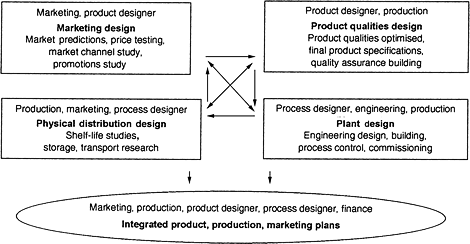FOOD
PRODUCT DEVELOPMENT
Mary Earle, Richard Earle and Allan Anderson |
| Loading
|
|
||||
|
|
Part
2, Chapter 3
The product development process 3.3.2 Commercial design There are four types of design in product commercialisation - marketing, product qualities, physical distribution and production plant, as shown in Fig.
3.11.
 Fig. 3.11 Design in product commercialisation. This is a time for many creative activities and they can career off into different directions. Nothing is worse than product qualities at variance with the marketing image of the product; for example product designers designing high- vitamin dog food and marketing building an image of a high-protein food. It is too late when the advertising designs come out and the designers say that that product is not what we designed! There needs to be close integration during the design and a final integration in the operational plans. These are the general areas of activities but the choice of specific activities and techniques depends on (Earle and Earle, 2000):  the type of product (incremental, innovation); the type of product (incremental, innovation);
 the type of marketing (consumer, industrial, food service); the type of marketing (consumer, industrial, food service);
 the amount of learning needed by the company, the distributors, the amount of learning needed by the company, the distributors, the consumers (high learning, low learning);  scale of entry (local, national, international); scale of entry (local, national, international);
 the time (long, short) and timing (wide range, crucial). the time (long, short) and timing (wide range, crucial).
For example, the time for the launch could be crucial because of competitive activity or the season, but the design has taken longer than expected, so the product commercialisation has to be rushed and the risk taken to drop some of the important activities. Companies often drop test marketing and business analysis when rushing to launch. But in all projects, time is expensive during commercialisation - an extra two weeks may make the costs shoot well over budget. So it needs to be well controlled. Creating knowledge is another important aspect of the marketing and production design - as in all other designs. This is a major area of industrial research. For the incremental new product, the company has a great deal of past production and marketing knowledge and it is a case of fine-tuning the knowledge to include perhaps some production improvement and some new competitive marketing activities. But for the product innovation, it is a learning experience for company staff, distributors and consumers. The path of diffusion of the new product is identified, through all functional groups and top management in the company, the sales staff, the storage and transport operators, the retailers, the buyers, the users and the final consumers of the food. The learning experiences of all participants need to be incorporated in the activities in the final plan. Costs, revenues and profits are now assuming major importance and need to be followed carefully in the designs so the final financial plan is acceptable to the top management and the launch agreed. |
|
 |